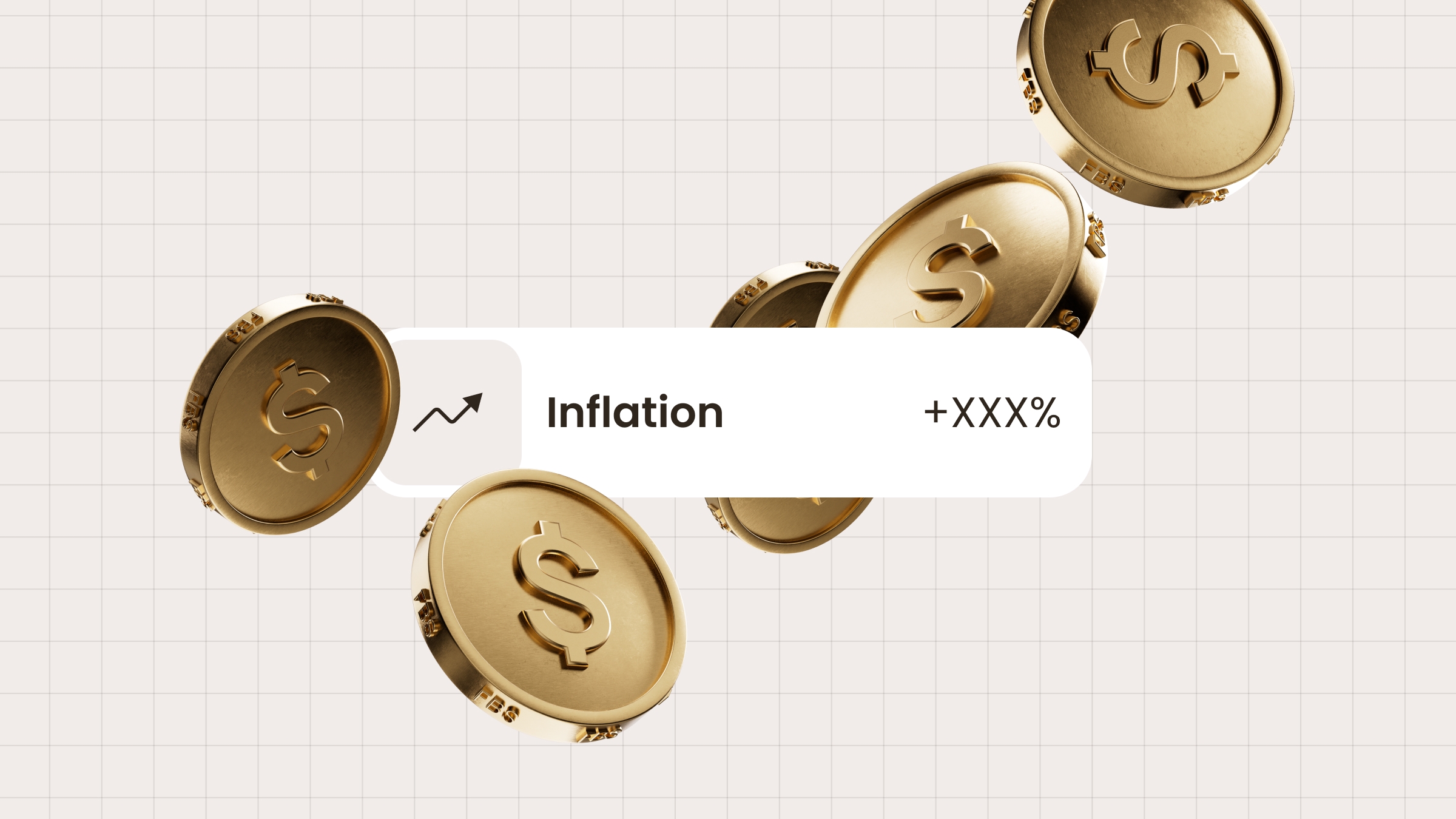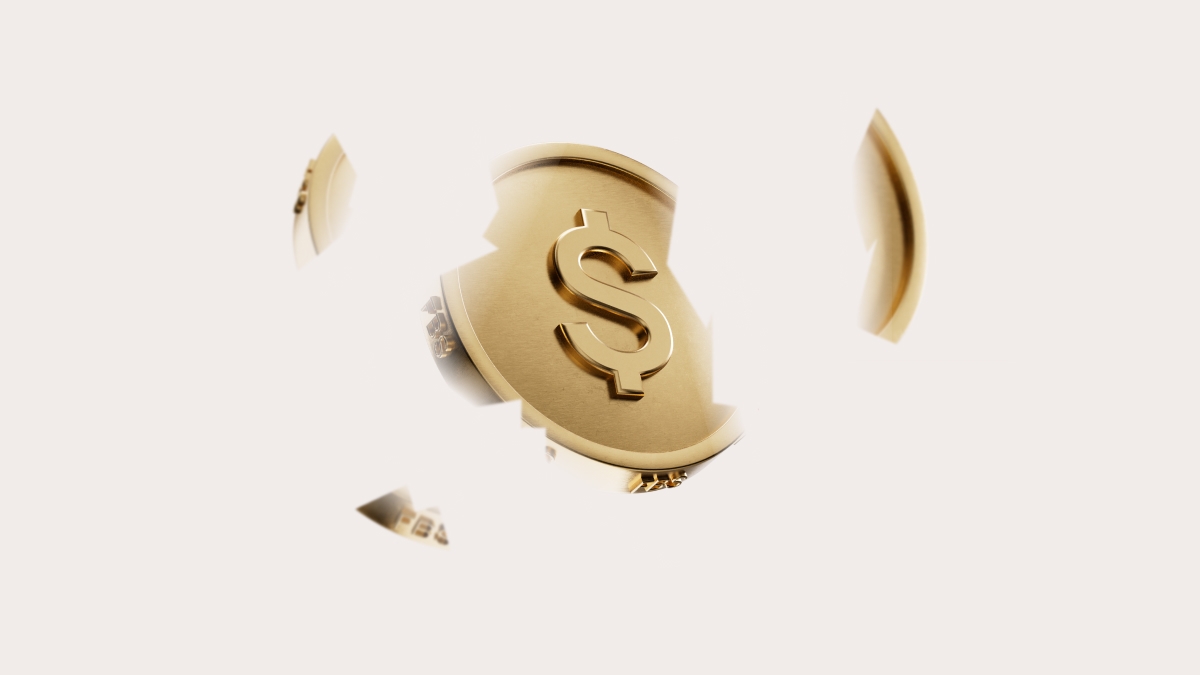
คุณอาจสังเกตเห็นได้ว่าราคาของผลิตภัณฑ์สุดโปรดของคุณได้เพิ่มขึ้นมาค่อนข้างมาก เหตุผลก็คืออัตราเงินเฟ้อที่สูงอย่างไม่น่าเชื่อส่งผลกระทบต่อเศรษฐกิจของประเทศต่าง ๆ ทั่วโลก
ในบทความนี้ เราจะมาเรียนรู้กันว่าเงินเฟ้อคืออะไร ทำไมมันถึงเกิดขึ้น ผลกระทบที่อาจเกิดขึ้นกับผู้บริโภคทั่วไป และอะไรคือสาเหตุของเงินเฟ้อในปี 2022
ประเด็นสำคัญ
- เงินเฟ้อ หมายถึง การเพิ่มขึ้นของราคาสินค้า ซึ่งทำให้ประชาชนจับจ่ายใช้สอยน้อยลง
- ภาวะเงินเฟ้ออาจเกิดจากความต้องการที่สูงสำหรับผลิตภัณฑ์บางอย่าง การเพิ่มขึ้นของราคาวัสดุ การลดค่าเงิน นโยบายของรัฐ และสถานการณ์อื่น ๆ
- ภาวะเงินเฟ้อต่ำสามารถช่วยให้เศรษฐกิจเติบโตได้ ในขณะที่ภาวะเงินเฟ้อสูงจะลดกำลังซื้อของผู้บริโภคและอาจนำไปสู่ภาวะเศรษฐกิจถดถอย
- ภาวะเงินเฟ้อของโลกในปัจจุบันของปี 2022 เกิดขึ้นจากผลพวงของการระบาดครั้งใหญ่ของ COVID-19 และวิกฤตด้านภูมิรัฐศาสตร์ในยูเครน
เงินเฟ้อคืออะไร?
เงินเฟ้อเป็นศัพท์ทางเศรษฐศาสตร์ที่ใช้อธิบายการเพิ่มขึ้นของราคาสินค้าและบริการที่ทำให้สูญเสียกำลังซื้อเมื่อเวลาผ่านไป โดยเงินเฟ้อเป็นตัวบ่งชี้ที่สำคัญ เนื่องจากแสดงให้เห็นว่าเศรษฐกิจของประเทศมีการเปลี่ยนแปลงมากน้อยเพียงใดภายในช่วงระยะเวลาหนึ่ง และการเปลี่ยนแปลงดังกล่าวส่งผลกระทบต่อสุขภาวะทางการเงินของประชากรในประเทศหรือไม่
โดยทั่วไปแล้ว เงินเฟ้อจะแสดงเป็นเปอร์เซ็นต์ที่แสดงอัตราการเพิ่มขึ้นของราคาภายในหนึ่งปี ตามปกติ เงินเฟ้อจะถูกคำนวณโดยหน่วยงานของรัฐที่รวบรวมข้อมูลเกี่ยวกับราคาปัจจุบันของตะกร้าสินค้าและบริการหนึ่ง ๆ โดยปกติตะกร้านี้ประกอบด้วยอาหาร แก๊ส เสื้อผ้า ยา พลังงาน ค่าผ่อนบ้าน ฯลฯ แต่องค์ประกอบภายในอาจแตกต่างกันไปขึ้นอยู่กับความผันผวนของราคาสินค้าบางชนิด ซึ่งทางหน่วยงานจะรวบรวมข้อมูลเกี่ยวกับราคาทุกเดือนแล้วหารต้นทุนเฉลี่ยของตะกร้าสินค้าด้วยต้นทุนของตะกร้าเดียวกันจากเดือนก่อนหน้า
สถิติของปีนี้แสดงให้เห็นว่าในเดือนตุลาคม ปี 2022 เงิน $100 ในสหรัฐอเมริกาสามารถซื้อตะกร้าสินค้าแบบเดียวกันได้ที่ราคา $92.81 ในเดือนตุลาคม ปี 2021 ซึ่งบ่งชี้ว่าอัตราเงินเฟ้อเพิ่มขึ้นอย่างมากตั้งแต่ปีที่แล้ว

สาเหตุหลักของภาวะเงินเฟ้อ
มีสาเหตุหลักหลายประการที่อาจส่งผลต่ออัตราเงินเฟ้อ
- อุปสงค์สูง อุปทานต่ำ เมื่อปริมาณความต้องการของประชากรต่อสินค้าและบริการบางอย่างเพิ่มขึ้นมากเกินไป เศรษฐกิจอาจไม่สามารถจัดหาสินค้าหรือบริการให้ได้เพียงพอ สิ่งนี้สร้างแรงกดดันต่อราคา ส่งผลให้เกิดเงินเฟ้อ ตัวอย่างเช่น ปัญหาการขาดแคลนนมผงสำหรับทารกของสหรัฐฯ ในปี 2022 เมื่อการเพิ่มขึ้นของราคาและปัญหาห่วงโซ่อุปทานทำให้ราคาของผลิตภัณฑ์ที่จำเป็นนี้พุ่งสูงขึ้น
- ต้นทุนสูง ราคาสูง เมื่อต้นทุนของวัสดุที่จำเป็นในการผลิตสินค้าเพิ่มขึ้น ราคาของสินค้าเหล่านี้ก็เพิ่มขึ้นเช่นกัน ตัวอย่างเช่น ต้นทุนของไม้ที่พุ่งสูงขึ้นถึง 400% ทำให้ราคาบ้านพุ่งสูงขึ้นเช่นกัน ส่งผลให้วิกฤตที่อยู่อาศัยในปัจจุบันครอบงำตลาดอสังหาริมทรัพย์ของสหรัฐฯ
- การลดค่าเงิน เมื่อประเทศหนึ่งประสบกับการลดค่าของสกุลเงิน อัตราแลกเปลี่ยนของสกุลเงินนั้นจะลดลง ส่งผลให้ค่าของสกุลเงินนี้มีค่าต่ำลง นี่เป็นข่าวดีสำหรับประเทศอื่น ๆ เนื่องจากการซื้อสินค้าส่งออกจากประเทศนี้มีราคาถูกลง แต่ในทางกลับกัน ประชาชนของประเทศนั้นไม่มีกำลังเพียงพอที่จะซื้อสินค้าที่นำเข้าจากต่างประเทศได้อีกต่อไป ซึ่งกระตุ้นให้ประชาชนหันมาซื้อสินค้าภายในประเทศแทน
- ปริมาณเงินที่เพิ่มขึ้น เมื่อเราพูดถึงปริมาณเงิน เราหมายถึงจำนวนเงินทั้งหมดที่หมุนเวียนในประเทศ รวมถึงเงินสด ยอดคงเหลือ และบัญชีธนาคาร หากปริมาณเงินนั้นเพิ่มขึ้น มันก็อาจนำไปสู่การขาดแคลนสินค้าได้ เนื่องจากอุปสงค์อาจมีมากกว่าอุปทานของสินค้า
- ค่าจ้างที่เพิ่มขึ้น เมื่อค่าจ้างสูงขึ้น ต้นทุนของแรงงานก็เพิ่มขึ้นเช่นกัน หมายความว่าธุรกิจต่าง ๆ ต้องปรับราคาสินค้าเพื่อรักษารายได้ของตนไว้ นอกจากนี้ ค่าแรงที่เพิ่มขึ้นยังหมายถึงกำลังซื้อของประชากรที่เพิ่มขึ้นด้วย ทำให้ความต้องการสินค้าบางอย่างพุ่งสูงขึ้นและราคาสูงขึ้นเนื่องจากสินค้าขาดตลาด
- นโยบายของรัฐ บางครั้งรัฐบาลก็ออกนโยบายและกฎระเบียบที่อาจทำให้ราคาสินค้าสูงขึ้น นโยบายดังกล่าวอาจรวมถึงการอุดหนุนด้านภาษีและอัตราดอกเบี้ยต่ำ ซึ่งทำให้ผู้บริโภคซื้อสินค้ามากขึ้นและทำให้ราคาสูงขึ้น
เงินเฟ้อ: ข้อดีและข้อเสีย
เงินเฟ้อไม่ใช่เรื่องเลวร้ายเสมอไป อัตราเงินเฟ้อที่ต่ำ (~2%) เป็นสิ่งที่ดีมากเนื่องจากกระตุ้นให้ผู้คนจับจ่ายใช้สอยกันมากขึ้น โดยประโยชน์ของเงินเฟ้อนั้นมีหลายประการ:
- เศรษฐกิจเติบโต ภาวะเงินเฟ้อจะเกิดขึ้นเสมอเมื่อเศรษฐกิจของประเทศกำลังเติบโต การเพิ่มขึ้นของราคาและค่าจ้างช่วยให้ธุรกิจทำเงินได้มากขึ้น ซึ่งช่วยขับเคลื่อนเศรษฐกิจให้ก้าวไปข้างหน้าและยืดระยะเวลาแห่งความมั่งคั่งทางเศรษฐกิจ
- การปรับค่าจ้าง เมื่อราคาสินค้าสูงขึ้น พนักงานก็เริ่มคาดหวังว่าจะได้ขึ้นค่าจ้างเพื่อให้เพียงพอกับค่าใช้จ่ายใหม่ ธุรกิจต่าง ๆ ต้องปรับค่าจ้างให้กับพนักงานของตน เพื่อทำให้แน่ใจว่าพวกเขาจะไม่ลาออกเพื่อไปหาที่ ๆ ให้ค่าจ้างสูงกว่าแทน นอกจากนี้ยังเป็นการช่วยให้นายจ้างได้ส่งเสริมพนักงานที่มีผลงานดี แถมยังสร้างสภาพแวดล้อมที่มีประสิทธิผลสูงในที่ทำงานอีกด้วย
- การปรับราคา เมื่อผู้คนมีรายได้เพิ่มขึ้น พวกเขาก็มีแนวโน้มที่จะจับจ่ายใช้สอยมากขึ้น สิ่งนี้ทำให้ธุรกิจได้รับโอกาสที่จะปรับราคาสินค้าของตนเพื่อต่อสู้กับความต้องการที่เพิ่มขึ้น และช่วยให้พวกเขาผลิตสินค้าที่มีคุณภาพสูงขึ้นสำหรับผู้บริโภคได้
- ลดมูลค่าที่แท้จริงของหนี้ เมื่อราคาและค่าจ้างสูงขึ้น หนี้ที่ผู้คนมีอยู่แล้วก็จะสูญเสียมูลค่าไป ปกติแล้วรัฐบาลมักจะผลักดันให้ลดอัตราดอกเบี้ยลง ซึ่งช่วยให้ประชาชนสามารถชำระหนี้ได้
- ดีกว่าเงินฝืด ภาวะเงินฝืดอาจเกิดขึ้นเมื่อมูลค่าของสกุลเงินลดลง สิ่งนี้นำไปสู่การลดลงของราคาสินค้า เนื่องจากหากไม่ทำเช่นนี้ผู้บริโภคก็ไม่สามารถซื้อได้ ในท้ายที่สุด การผลิตสินค้าอาจไม่สามารถทำกำไรได้อีกต่อไป ซึ่งนำไปสู่การหยุดชะงักทางเศรษฐกิจ
อย่างไรก็ตามเมื่ออัตราเงินเฟ้อสูงอย่างเช่นในปัจจุบัน มันก็ก่อให้เกิดปัญหามากมาย
- เมื่อค่าจ้างไม่ได้ปรับตามราคาที่เพิ่มขึ้น ผู้คนจึงต้องใช้รายได้และเงินออมที่มีอยู่เพื่อซื้อสินค้าที่จำเป็น สิ่งนี้จะลดศักยภาพในการออมและลงทุนเงินของพวกเขา ซึ่งทำให้การเติบโตทางเศรษฐกิจของประเทศชะลอตัวลง
- อัตราเงินเฟ้อที่สูงขึ้นทำให้ราคาสินค้าเพิ่มขึ้น สิ่งนี้ทำให้ผลิตภัณฑ์ของประเทศไม่สามารถแข่งขันในตลาดโลกได้ ซึ่งนำไปสู่การส่งออกที่น้อยลง ในทางกลับกันประชากรของประเทศนั้น ๆ ก็ประสบความลำบากที่จะซื้อสินค้าประเภทเดียวกันนี้
- อัตราเงินเฟ้อสามารถลดมูลค่าของพันธบัตรรัฐบาลได้ ทำให้นักลงทุนต้องการผลตอบแทนมากขึ้น หนทางเดียวที่ทำได้คือเพิ่มอัตราดอกเบี้ยหนี้ของประชาชน และตัดกำลังซื้อของพวกเขาลงไปอีก
- อัตราเงินเฟ้อที่สูงทำให้รายได้ที่แท้จริงของครัวเรือนลดลง ซึ่งมีแต่จะทำให้ความไม่เท่าเทียมกันของรายได้รุนแรงขึ้น และสร้างช่องว่างที่กว้างขึ้นระหว่างชนชั้นที่มีรายได้สูงและต่ำ
- ภาวะเงินเฟ้อเป็นเรื่องยากที่จะต่อสู้ และมาตรการที่รัฐบาลตัดสินใจใช้อาจนำไปสู่การว่างงานในระยะสั้นและแม้กระทั่งภาวะถดถอยทางเศรษฐกิจ